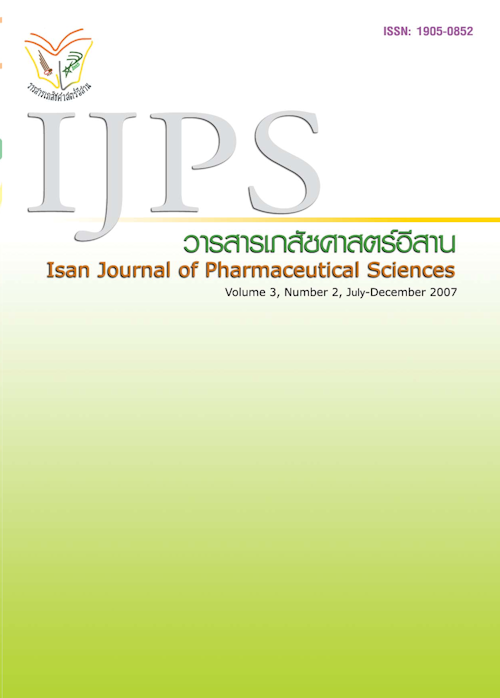การกักเก็บนํ้ามันรำข้าวในโซลิดลิปิดนาโนพาร์ทิเคิลสำหรับเพิ่มความชุ่มชื้นและความยืดหยุ่นผิว
Main Article Content
บทคัดย่อ
งานวิจัยนี้มีวัตถุประสงค์เพื่อกักเก็บน้ำมันรำข้าวในโซลิดลิปิดนาโนพาร์ทิเคิล (SLN) ด้วยเทคนิคโฮโมจีไน เซชันความดันสูง และได้ศึกษาปัจจัยของส่วนประกอบตำรับ (ความเข้มข้นของไขมัน สารลดแรงตึงผิวและน้ำมัน รำข้าว) และกระบวนการผลิต (ความดันและเวลาที่ลดขนาดด้วยเครื่องไฮเพรชเชอร์โฮโมจีไนเซอร์) ต่อคุณสมบัติทางกายภาพของ SLN ตำรับที่พัฒนาได้นำไปศึกษาประสิทธิภาพในการเพิ่มความชุ่มชื้นและความยืดหยุ่นของผิวในอาสาสมัคร 10 คน พบว่าตำรับที่ดีที่สุดคือ SLN ที่มีขนาดอนุภาคเล็กกว่า 200 nm ที่เตรียมจาก Compritol® 888 ATO น้ำมันรำข้าว และ Pluronic® F68 ในความเข้มข้นต่ำกว่า 2.5, 2.5 และสูงกว่า 2.5%w/w ตามลำดับ การใช้ความดันในการปั่นผสมที่ 500 ถึง 700 บาร์ให้ขนาดอนุภาคลดลงอย่างมีนัยสำคัญจาก 500 เป็น 160 nm ค่าเฉลี่ยอนุภาคของ SLN (160±20 nm และดัชนีการกระจายอนุภาค<0.2) ที่ได้ไม่เปลี่ยนแปลงอย่างน้อย 28 วัน เมื่อเก็บที่อุณหภูมิ 25 °C ครีมที่มีส่วนผสมของน้ำมันรำข้าวที่กักเก็บใน SLN (น้ำมันรำข้าว 1.28%w/w, อัตราส่วน SLN ต่อครีมพื้นเท่ากับ 51.2:48.8 %น้ำหนัก) ทำให้ผิวมีความชุ่มชื้นสูงกว่าผิวที่ทาครีมพื้นหลังใช้ในวันที่ 7, 14 และ 28 ส่วนความยืดหยุ่นผิวเพิ่มขึ้นในราว 4-5 % อย่างมีนัยสำคัญหลังใช้ในวันที่ 7, 14 และ 28 ตามลำดับ (p<0.05) ดังนั้น SLN จึงสามารถใช้กักเก็บน้ำมันรำข้าวเพื่อเป็นระบบนำส่งในการเพิ่มความชุ่มชื้นและความยืดหยุ่นของผิวได้
Article Details
กรณีที่ใช้บางส่วนจากผลงานของผู้อื่น ผู้นิพนธ์ต้อง ยืนยันว่าได้รับการอนุญาต (permission) ให้ใช้ผลงานบางส่วนจากผู้นิพนธ์ต้นฉบับ (Original author) เรียบร้อยแล้ว และต้องแนบเอกสารหลักฐาน ว่าได้รับการอนุญาต (permission) ประกอบมาด้วย
References
Akihisa T, Yasukawa K, Yamaura M, et al. 2000. Triterpene alcohol and sterol ferulates from rice bran and their anti-inflam-matory effects. J Agri Food Chem 48 (6): 2313-2319.
Amended final report. 2006. The safety assessment of Oryza sativa (rice) bran oil, Oryza sativa(rice) germ oil, rice bran acid, Oryza sativa (rice) bran wax, hydrogenated rice bran wax, Oryza sativa (rice) bran extract, Oryza sativa (rice) extract, Oryza sativa (rice) germ powder, Oryza sativa (rice) starch, Oryza sativa (rice) bran, hydrolyzed rice bran extract, hydrolyzed rice bran protein, hydrolyzed rice extract, and hydrolyzed rice protein 1. Int J Toxicol 25: 91-120.
Asasutjarit R, Lorenzen SI, Sirivichayakul S, et al. 2007. Effect of solid lipid nanoparticles formulation compositions on their size, zeta potential and potential for in vitro pHIS-HIV-Hugag Transfection. Pharm Res 24(6): 1098-1107.
Bramley PM, Elmadfa I, Kafatos A, et al. 2000. Review vitamin E. J Sci Food Agric 80: 913-938.
Bravi E, Perretti G, Montanari L. 2006. Fatty acids by high-performance liquid chroma-tography and evaporative light-scattering detector. J Chromatogr A 1134: 210-214.
Bucci R, Magrì AD, Magrì AL, et al. 2003. Comparison of three spectrophotometric methods for the determination of gamma-oryzanol in rince bran oil. Anal Bioanal Chem 375(8): 1254-1259.
Charcosset C, El-Harati A, Fessi H. 2005. Preparation of solid lipid nanoparticles using a membrane contactor. J Control Release 108(1): 112-120.
Dingler A, Blum RP, Niehus H, et al. 1999. Solid lipid nanoparticles (SLN/Lipopearls)-a pharmaceutical and cosmetic carrier for the application of vitamin E in dermal products. J Microencapsul 16(6): 751-767.
Gavini E, Cossu M, Rassu G, et al. 2007. Solid lipid nanoparticles (SLN) as carriers for the topical delivery of econazole nitrate: in-vitro characterization, ex-vivo and in-vivo studies. J Pharm Pharmacol 59(8): 1057-1064.
Iwatsuki K. 2003. Sterol ferulates, sterols, and 5-alk(en)ylresorcinols from wheat rye, and corn bran oil and their inhibitory on Epstein-barr virus activation. J Agri Food Chem 51(23): 663-668.
Jenning V, Gohla S. 2001. Encapsulation of retinoids in solid lipid nanoparticles (SLN). J. Microencapsul 18: 149-158.
Jenning V, Gysler A, Schafer-Korting M, et al. 2000. Vitamin A loaded solid lipid nanoparticles for topical use: occlusive properties and drug targeting to the upper skin. Eur J Pharm Biopharm 49(3): 211-218.
Jenning V, Schafer-Korting M, Gohla S. 2000. Vitamin A-loaded solid lipid nano- particles for topical use: drug release properties. J Control Release 66 (2-3) 115-126.
Kuntsche J, Bunjes H, Fahr A, et al. 2007. Interaction of lipid nanoparticles with human epidermis and organotypic cell culture model. Int J Pharm. Doi:10.1016/j.ijpharm.2007.08.028.
Lourenco C, Teixeira M, Simões S, et al. 1996. Steric stabilization of nanoparticles: size and surface properties. Int j Pharm 138: 1-12.
Müller RH, Maassen S, Weyhers H, et al. 1996. Phargocytic uptake and cytotoxicity of solid lipid nanoparticles (SLN) sterically stabilized with poloxamer 908 and poloxamer 407. J Drug Target 4(3): 161-170.
Müller RH, Mäder K, Gohla S. 2000. Solid lipid nanoparticles (SLN) for controlled drug delivery-a review of the state of the art. Eur J Pharm Biopharm 50(1): 161-177.
Nyström L, Achrenius T, Lampi AM, et al. 2006. A comparison of the antioxidant properties of steryl ferulated with tocopherol at high temperature. J Agric Food Chem 53(7): 2503-2510.
Pople PV, Singh KK. 2006. Development and evaluated of topical formulation containing solid lipid nanoparticles of vitamin A. AAPS Pharm Sci Tech 7 (4): 91.
Renuka Devi R, Arumughan C. 2007. Antiradical efficacy of phytochemical extracts from defatted rice bran. Food Chem Toxicol 45(10): 2014-2041.
Scientific measurements of skin and hairindispensable for dermatology & cosmetology. http://courage- khazaka. de/products/scientific rd prod.htm. Accessed October 31, 2005.
Sierra S, Lara-Villoslada F, Olivares M, et al. 2005. Increased immune response in mice consuming rice bran oil. Eur J Nutr 81(1): 64-68.
Song C, Liu S. 2005. A new healthy sunscreen system for human: solid lipid nanoparticles as carrier for 3,4,5-trime-thoxybenzoylchitin and the improvementby adding vitamin E. Int J Biol Macromol 36 (1-2): 116-119.
Souto EB, Müller RH, Gohla S. 2005. A novel approach based on lipid nanoparticles (SLN) for topical delivery of alpha-lipoic acid. J Microencapsul 22(6): 581-592.
Taylor JB, Richar TM, Wilhelm CL, et al. 1997. Rice-bran oil antioxidant. Trends Food Sci Tech: 207. Wissing SA, LipacherA, Müller RH. 2001. Investigations on the occlusive properties of solid lipid nanoparticles (SLN). J Cos Sci 52(5): 313-324.
Wissing SA, Müller RH. 2002. The influence of the crystallinity of lipid nanoparticles on their occlusive properties. Int Pharm 242(1-2): 377-379.
Wissing SA, Müller RH. 2003. The influence of solid lipid nanoparticles on skin hydration and viscoelasticity in vivo study. Eur J Pharm Biopharm 56: 67- 72.

